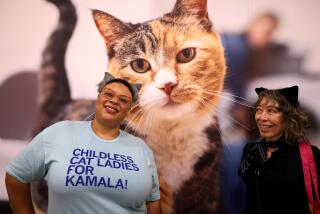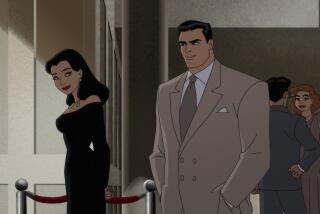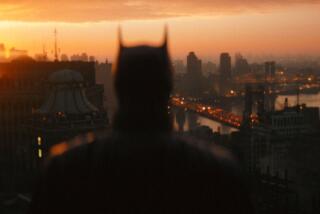New Cassandra Cain graphic novel shows Asian American girls can be Batgirl too
- Share via
Cassandra Cain is a teenage assassin who was only ever taught how to fight and kill. She was trained from birth to be her father’s perfect weapon.
Debuting in a 1999 issue of “Batman,” she’s a Bat-family character known for her violent backstory in DC’s main comics universe who’s spent time both as a superhero and a super villain.
In “Shadow of the Batgirl,” a young-adult graphic novel from author Sarah Kuhn and artist Nicole Goux, Cassandra gets a new origin story where she learns that being a hero or a villain is about the choices a person makes. Kuhn and Goux will be discussing their book at an event at the Ripped Bodice, Culver City’s romance-only bookstore, on Saturday.
“I love that she was a character who had all the tools and training and everything to be a super villain and then decides to be a hero instead,” said Kuhn in a recent interview at DC Entertainment’s Burbank office.
One of the reasons the “Heroine Complex” and “I Love You So Mochi” author has long been a “mega, mega Cassandra Cain fan” was because she was the “Asian Batgirl.”
“Being Asian American, it was really important to me to see her headlining her own book,” said Kuhn of Cassandra’s “Batgirl” comic series.
Like many superhero comic book characters, Cassandra in the main DC continuity has been rebooted, reimagined and renamed a number of times over the years (her current alias is Orphan). And a live-action interpretation of the character, played by Ella Jay Basco, makes her debut in “Birds of Prey (and the Fantabulous Emancipation of One Harley Quinn),” which hit theaters Friday.
For their new book, Kuhn and Goux introduce an incarnation of Cassandra who takes on the Batgirl mantle once again.
This Cassandra is surprised by a paradigm-shifting moment during a mission that leads her to break away from the only life she has ever known — being an assassin for her father, David Cain.
Having been raised deprived of any spoken or written language, Cassandra’s journey includes learning how to read and to communicate with other people as well as what it means to be “good” or “bad” as she starts to figure out her own identity.
Goux explained that among the things they had to resolve artistically was “how [to] communicate that [Cassandra’s] learning to read in this way and that she’s not understanding these words. That they’re real words, not just squiggles.”
The minimal dialogue was “an opportunity to really work through the acting of the characters, and the body language and the facial expressions, to communicate what they are thinking and feeling,” said Goux. “I think that is really integral to Cass as a character, not just in the way that we’re telling the story but who she is and how she interprets the world.”
As a writer known for work that is generally more “fun and joyous and happy,” Kuhn said it was a challenge to push herself to explore the darker aspects of Cassandra’s backstory in a meaningful and authentic way.
“Her story is so violent,” said Kuhn. “There’s trauma and abuse and other heavy issues.”
And she credit’s Goux’s art for helping her really connect with Cassandra and the story they wanted to tell.
“There’s so much empathy in that design,” said Kuhn. “That made me really want to find the joy for her. To write those first moments after she’s escaped her abusive father and she is finding happier things, more joyful things, connections with people [and] love of all different kinds.”
Two people who take an interest in Cassandra and her well-being are Barbara from the library, who knows an awful lot about gadgets and Batgirl, and Jackie Fujikawa Yoneyama, who owns a ramen shop.
While Barbara and Cassandra’s relationship is rooted in comic book history, Jackie is a “Shadow of the Batgirl” original character.
“It was really important to me that Cass had someone to look up to who was an Asian American woman, because in my own life that has certainly been important to me,” said Kuhn. “I thought for Cass it would be important to have someone who kind of looks like her when she’s older, who is mentoring her and helping her. Making her see that she can be the center of her own story.
“And, of course, I love Asian aunties,” she said.
Goux added that developing Jackie’s personal style “was such a fun place to play” but it was also an element that was significant for Cassandra’s character development.
“Jackie is an older stern figure, but she’s also really fun and she is very expressive and she knows what she wants. That’s very evident in the way that she dresses herself,” said Goux. “Cass, she’s never gotten to dress herself in her entire life.”
To be able to see someone like Jackie, who clearly chooses her own clothes and style without letting others dictate her decisions, empowers Cassandra to make choices like that for herself too. And it also allows Cass to make her own amazing custom Batgirl outfit.
“One of my favorite parts of the book is that when Cassandra makes her first DIY Batgirl outfit, she uses some of the things Jackie’s given her. Jackie’s old clothes,” said Kuhn. “And one thing that Nicole designed that I thought was so cool was she takes that wild flower-printed garment and makes it into her cape. When I saw that, I was like, ‘That is the most Asian thing I’ve ever seen.’”
What Kuhn also relates to with her Cassandra is that in the beginning, it doesn’t even occur to the teen that she could become a hero. It’s a feeling she believes many people of color have experienced with superhero stories due to lack of representation.
She hopes “Shadow of the Batgirl” can help change that.
“I want young Asian American girls to feel like they could be Batgirl,” said Kuhn. “I want them to feel seen. I want them to feel like they can be a main character and they can be this superhero with this epic, historic, legendary mantle.”
More to Read
Sign up for our Book Club newsletter
Get the latest news, events and more from the Los Angeles Times Book Club, and help us get L.A. reading and talking.
You may occasionally receive promotional content from the Los Angeles Times.











